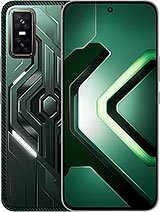Infinix GT 30 alternatives
Tap above to see alternatives.
Realme Narzo 70 Turbo alternatives
Tap above to see alternatives.
Infinix GT 30

Infinix GT 30
-
Dimensity 7400
4 nm
-
5500 mAh
45W
-
6.78"
1224 x 2720 pixels
-
64 MP
4K@30fps
- Specs
Realme Narzo 70 Turbo

Realme Narzo 70 Turbo
-
Dimensity 7300 Energy
4 nm
-
5000 mAh
45W
-
6.67"
1080 x 2400 pixels
-
50 MP
4K@30fps
-
Specs

4x2.6 GHz Cortex-A78
4x2.0 GHz Cortex-A55
4x2.5 GHz Cortex-A78
4x2.0 GHz Cortex-A55
8GB 256GB (UFS 2.2)
8GB 128GB (UFS 3.1)
12GB 256GB (UFS 3.1)
f/1.75, 23mm (wide), 1/1.73", 0.8μm, PDAF
8 MP
f/2.2, 111˚, (ultrawide), AF
f/1.8, 27mm (wide), PDAF
2 MP
f/2.4, (depth)
Auxiliary lens (flicker sensor)
1080p@30/120fps
1080p@30/60/120fps
f/2.2, 25mm (wide)
f/2.4, (wide)
1080p@30fps
SIM1: Nano, SIM2: Nano
11 5G bands
n1, n3, n5, n6, n8, n28, n38, n40, n41, n77, n78
9 5G bands
n1, n3, n5, n8, n28, n40, n41, n77, n78
In this performance comparison, the Infinix GT 30 with its MediaTek Dimensity 7400 (4nm) performs better than the Realme Narzo 70 Turbo with the Mediatek Dimensity 7300 Energy (4nm), thanks to superior chipset efficiency.
Both Infinix GT 30 and Realme Narzo 70 Turbo offer the same software support — 2 years of OS updates and 3 years of security updates.
Both Infinix GT 30 and Realme Narzo 70 Turbo feature AMOLED displays, offering vibrant colors and deeper blacks. In terms of smoothness, Infinix GT 30 offers a higher 144 Hz refresh rate, ensuring fluid scrolling and animations. Realme Narzo 70 Turbo also boasts a brighter screen with 2000 nits of peak brightness, enhancing outdoor visibility. Notably, Infinix GT 30 offers a higher screen resolution, resulting in sharper visuals and more detailed content.
Infinix GT 30 comes with a larger 5500 mAh battery, which may offer longer usage on a single charge. Both devices support the same wired charging speed of 45W.
Realme Narzo 70 Turbo offers better protection against water and dust with an IP65 rating.
- Realme Narzo 70 Turbo – Check price here
¹ Scores can vary even with the same chipset due to RAM, thermals, and software optimization.








